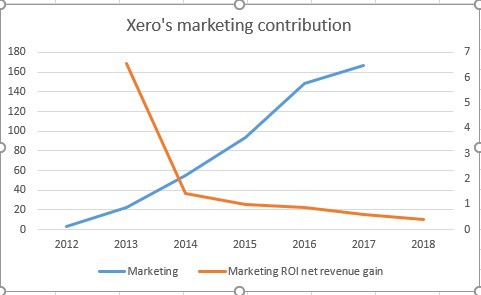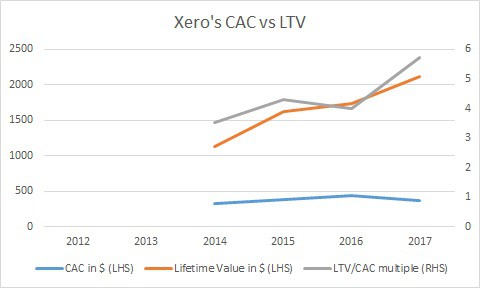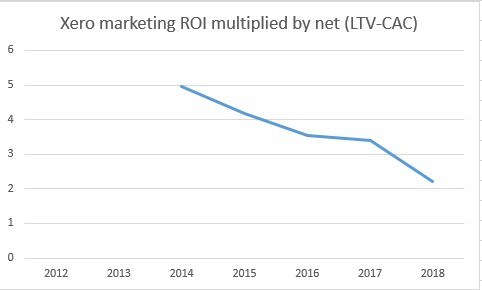I own shares in accounting software company XERO FPO NZX (ASX: XRO). As I've commented previously, the company looks expensive, but I also think it is closer to a buy than a sell.
Given that the company is unprofitable, it is difficult to use standard measures like Return on Investment (ROI) or Return on Equity (ROE) to quantify the actual value that Xero is creating for shareholders.
There are numerous other metrics that investors look at, with subscriber numbers, average revenue per user, churn, and customer lifetime value among the most prominent. However, I wanted to try and quantify the return on marketing investment that Xero is getting to see if it is getting harder to acquire each new dollar of revenue.
Marketing expense is probably one of the best predictors of Xero's future revenue growth. However, given the subscription nature of Xero's product, marketing expense in the current year isn't a good predictor of this year's earnings.
Marketing expense in the previous year is more predictive, in my opinion, because customers acquired in the previous year will pay for a full 12-month subscription in the current year.
I took the revenue added in the current year and divided it by the prior year's marketing expenses to get a multiple which I call Xero's marketing Return On Investment (ROI) multiple:

I used Xero's annualised committed monthly revenue (ACMR) as a proxy for 2018 revenue. Actual 2018 revenue (and thus the ROI) could be higher or lower.
This is an imperfect proxy for Xero's growth. However, some of the company's marketing will be 'stay in business' marketing and I thought this ratio might also be a good way to account for that.
You can see in the above chart that the return on Xero's marketing expenditure (orange line) has fallen sharply and continues to decline, even as marketing expense in millions of $ (blue line) continues to grow.
This means that Xero is spending more on marketing to achieve less in new sales. In 2017 Xero spent $166.8 million on marketing, and at the end of 2017, the company had annualised committed monthly revenue of $359.7 million, $64.3 million higher than actual revenue. This suggests that revenue will be at least $64.3 million higher in 2018.
$166.8 million in marketing divided by $64.3 million in new revenue (i.e. marketing / new revenue) equates to a ratio of 0.385. That is, every dollar spent on marketing in 2017 could lead to ~$0.385 in new sales in 2018. This figure was above $1 as early as 2016.
This is still a worthy return on investment (given the high margins of the software business) but it shows that it is getting more expensive for Xero to grow. This may be partly due to the expense of expanding overseas where Xero is still building its brand, and has lower customer numbers.
The second thing I wanted to check at was the actual value generated by each new customer. To do this I divided the 'Lifetime Value' of a customer (LTV) by the Cost of Acquiring a Customer (CAC) (this data has been provided in Xero's annual reports since 2015):

Notably while the return on marketing expense appears to be falling, the value generated by each customer (orange line) is increasing. Additionally, even after the cost of acquiring a customer is accounted for (blue line), the value that each customer adds is still increasing (grey line).
In simple terms, the grey line suggests that Xero could generate revenue equivalent to 5.7x the cost of acquiring that customer. Now revisit the first chart where I suggested that the return on marketing dollars is falling and could be as low as 0.385 in 2018.
Multiply that figure (the percent of marketing expenditure added as new revenue) by the lifetime value of that revenue and you get this:

While every $1 on marketing might generate $0.385 in new sales in 2018 (the first chart in this article), over a customer's lifetime, it could generate up to 5.7x this value (second chart), or $2.19.
This suggests that every $1 spent on marketing currently creates 2.19 times that amount over time. This marketing ROI has been falling sharply in recent times (third chart) and may continue to decline. However, there are a few takeaways from this:
- Xero is still generating considerable returns on its investment (in the form of lifetime value) and likely will do so for some time, even if the ROI on marketing expense continues to decline.
- Xero's customer lifetime value and average revenue per user generally continue to increase. The above charts are snapshots at a point in time and appear more negative than has proven to be the case.
- The missing part of the picture here is research & development spending, which will prove key to creating new opportunities to generate new revenue from the existing customer base – a largely untapped opportunity to date.
In summary, Xero shares appear a little expensive to me at current prices. However, although it is yet to make a profit according to accounting standards, the current economics of the business appear favourable. If Xero continues to invest in opportunities which create more value than they cost, the company could be expected to continue growing over time.







